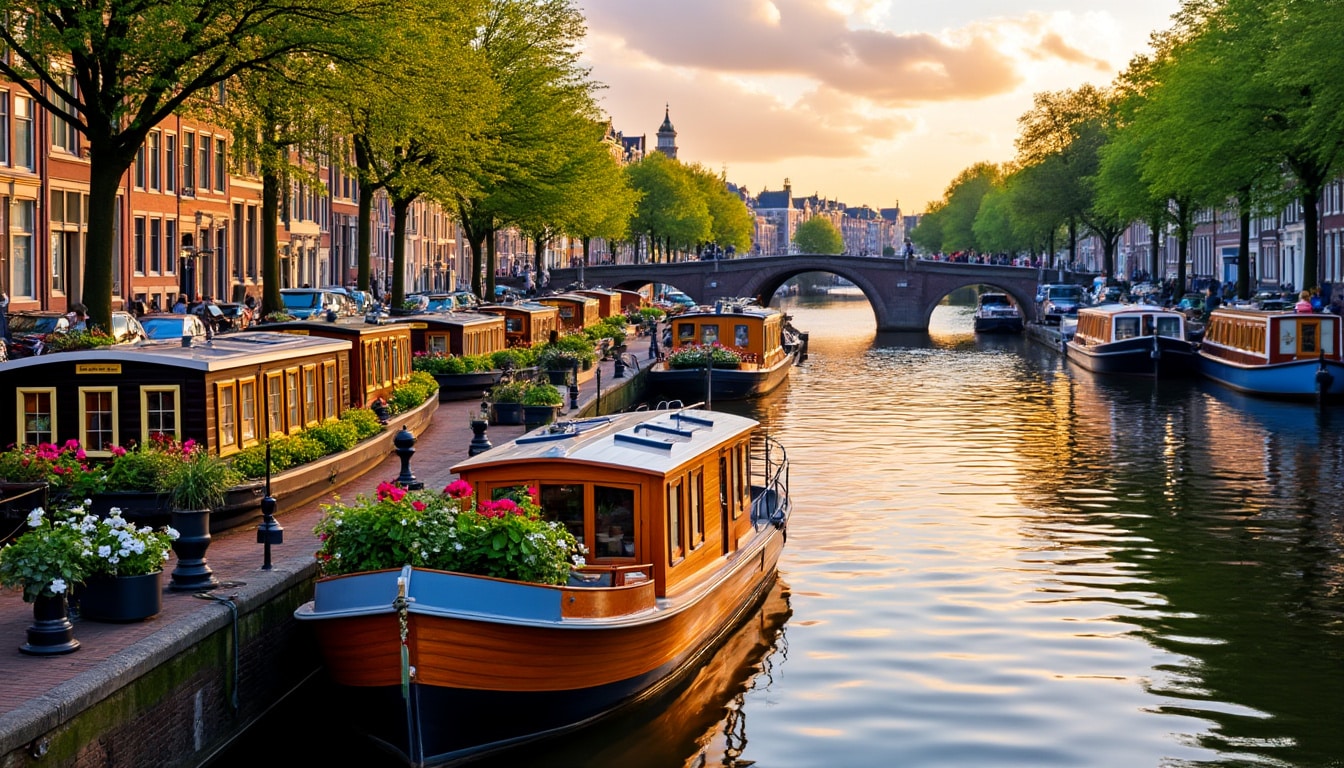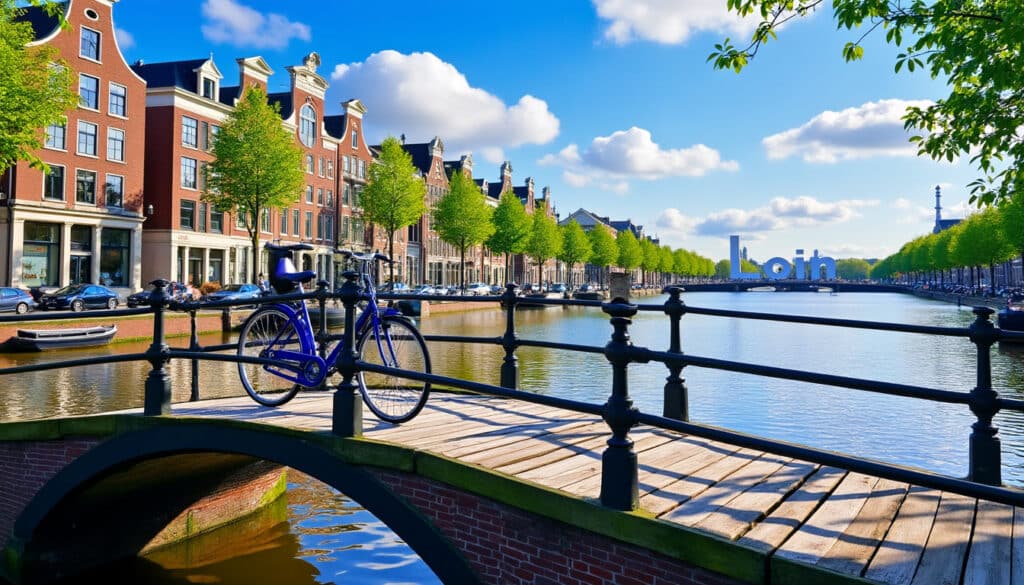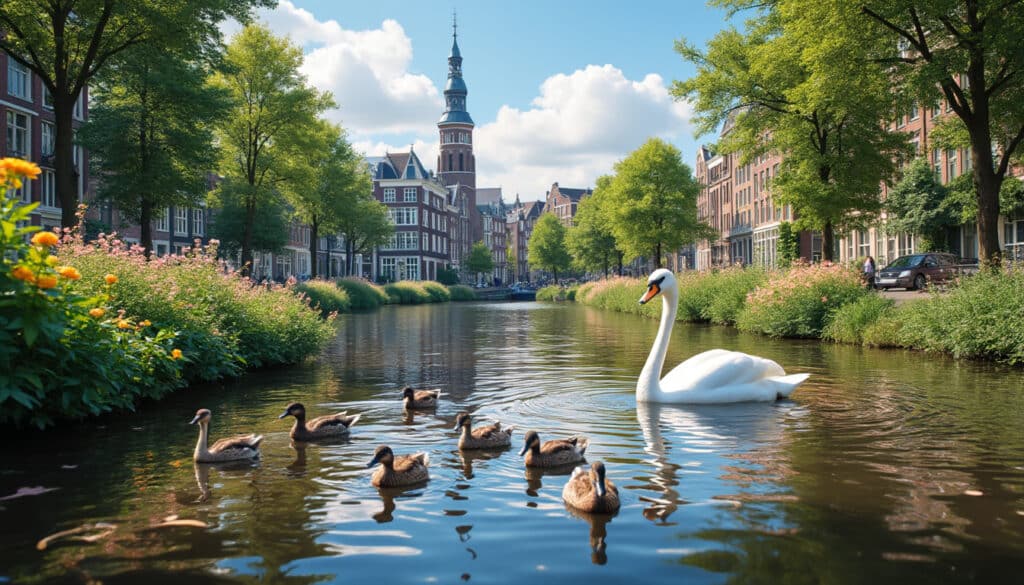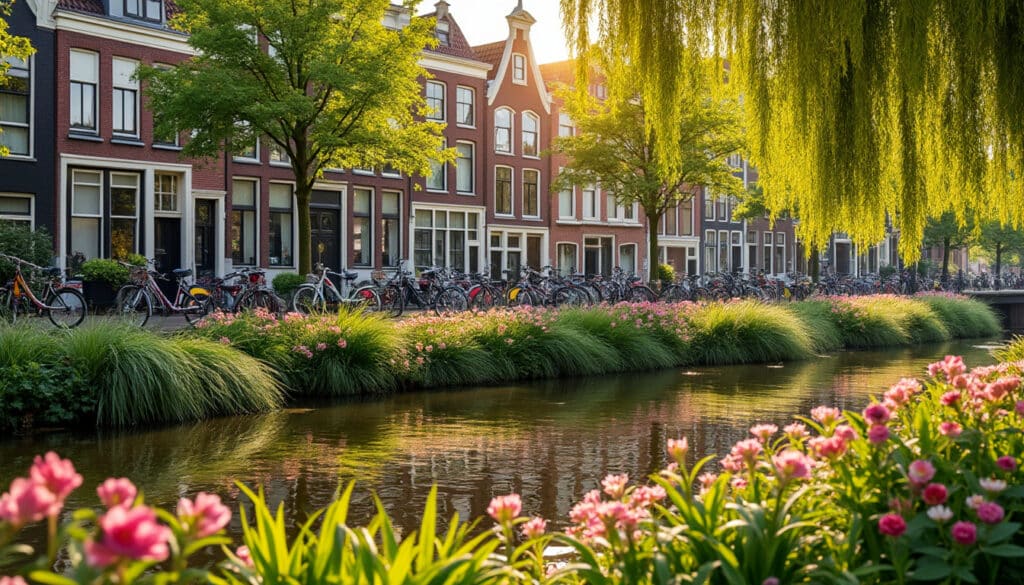Amsterdam, often called the “Venice of the North,” captivates its visitors with an intricate network of canals, lush parks, and architectural marvels. Known for its liberal culture and historical significance, this city stands at the crossroads of water and land. With its famous canals and iconic tilt of canal houses, Amsterdam reflects centuries of water management and Dutch ingenuity. Here, we delve into the geographical wonders that have shaped this vibrant city into a global attraction.
Exploring Amsterdam’s Unique Canal System
Amsterdam’s canal system, which blankets the city like a calm web, is one of its most outstanding geographical features. Forming a semicircle around the city center, these canals were constructed during the 17th century, a period known as the Dutch Golden Age. During this time, the design was not only an aesthetic endeavor but a strategic necessity to reclaim land from marshy grounds and keep the sea at bay. The three primary canals known as the Grachtengordel—Herengracht, Prinsengracht, and Keizersgracht—play host to myriad activities and spectacular views.
Canal tours (Amsterdam Canal Tours) offer a spectacular perspective of the cityscape, allowing both residents and visitors to explore Amsterdam’s history from the water. Many canal houses, originally built as homes for wealthy merchants, now serve as tourist attractions, cafes, or cultural insights into the city’s past. The canal belt, recognized as a UNESCO World Heritage site, emphasizes the intricate planning and architectural finesse of early Dutch urban design.
- 🚲 Herengracht – Often seen hosting events and festivals
- 🚲 Prinsengracht – Known for its vibrant cultural nuances
- 🚲 Keizersgracht – The widest of the three, lined with majestic canal houses
The canals also serve modern-day Amsterdam by catering to houseboats, marking a unique housing tradition embraced by many Amsterdammers. Each year, the city’s canals attract millions of tourists who flock to experience their serene beauty, further enriching Amsterdam’s cosmopolitan charm.
Beyond aesthetics and tourism, Amsterdam’s canals have significantly impacted city planning and urban development. With the advantage of water routes, residential areas spread efficiently whilst maintaining green spaces and parks like the Vondelpark, which complements the cityscape by offering lush retreats within the urban expanse. The canals stand as a testament to the Dutch people’s relentless innovation in harnessing natural landscapes for sustainable living.

Land Reclamation and the Formation of Polders
One of the remarkable geographical feats that define Amsterdam is its land reclamation process, bringing to life thousands of hectares of usable land from marshy wetlands. The Netherlands, known for its innovative engineering, has reclaimed over one-fifth of its land from the sea, and Amsterdam is a prime example of this transformation.
Polders, which are low-lying areas below sea level surrounded by dikes, form the backbone of Amsterdam’s landscape. The history of the city reflects continuous innovation in water management techniques, driven by necessity and ingenuity. This form of land creation and water management is essential to understanding Amsterdam’s geographical narrative and becoming a significant cultural aspect of Dutch life.
The most famous polder in Amsterdam is the Beemster Polder, a UNESCO World Heritage site. Demonstrating the Dutch mastery of water management, the polder presents an artificial landscape showcasing precise geometric blocks with intricate drainage systems.
| 🌍 Polder | 🛑 Conquered Land | 💧 Water Management Techniques |
|---|---|---|
| 🐄 Beemster | Pioneering polder with precise grid layout | Network of windmills and canals |
| 🥕 Haarlemmermeer | Drained lake, now a fertile agricultural region | Steam-powered pumping stations |
| 🌾 Schermer | Large expanses of farmland below sea level | Advanced windmill technology |
The continued success of polders relies on maintaining the delicate balance of water levels, achieved through a blend of traditional techniques and modern technology. The dikes, controlled by durable pumps and integrated drainage systems, ensure Amsterdam remains a vibrant city bustling with life, despite sitting largely below sea level.
- 📜 Kept dry since the 17th century
- 🌟 Testament to Dutch engineering prowess
- 🚜 Agricultural productivity boosted
A Hub of Culture: Amsterdam’s Museum Quarter
Amsterdam’s rich cultural landscape is well represented in the Museum Quarter, a focal point for art and history in the Netherlands. Situated in the vibrant district of Zuid, the Museum Quarter is home to a concentration of the city’s leading cultural institutions, offering insights into Amsterdam’s storied past and thriving arts scene.
The museums within this cultural Mecca include the Rijksmuseum, known for its impressive collection of Dutch masterpieces, the Van Gogh Museum hosting the world’s most extensive assembly of Van Gogh’s works, and the Stedelijk Museum, lauded for modern and contemporary art.
Visitors experience an immersive journey through time, exploring a breadth of exhibits spanning centuries of artistic endeavor. For example, the Rijksmuseum not only highlights artwork from the Dutch Golden Age but also depicts historical artifacts that trace the evolution of society through the ages.
- 🖼️ Various styles of paintings from Baroque to Post-Impressionism
- 🖌️ Interactive displays and cutting-edge art installations
- 🎨 Special exhibitions featuring works from around the globe
The Museum Quarter also hosts the Concertgebouw, recognized globally for its acoustic brilliance, and the tranquil Vondelpark, providing serene green space for relaxation and cultural events alike.
The district’s vibrant environment is enriched by outdoor markets and quaint cafes, making it an ideal place for embracing Amsterdam’s cultural heartbeat. From discovering world-renowned art to engaging in leisurely park strolls, the Museum Quarter is an essential stop for both art enthusiasts and those looking to capture Amsterdam’s geographic charm.
Amstel River and Amsterdam’s Water Highway
The city’s lifeblood, the Amstel River, weaves through Amsterdam, shaping its physical landscape and cultural identity. Named after this river, “Amstel-dam” signifies the city’s efforts to control water in its formative years, which included creating a dam at its mouth.
Today, the Amstel River acts as a key waterway for commerce and recreation. It acts as a liaison between urban development and nature, enhancing the amenities of Amsterdam through an aquatic avenue. Attractions such as the St. Nicholas Basilica and The Amsterdam Dungeon find themselves ideally positioned by the river, blending historical riches with scenic beauty.
Amsterdam’s ability to harness the potential of its rivers and waterways in the past has been nothing short of remarkable. Innovations in transport, from early trade boats to modern cruises, make the Amstel River a vital artery, continually spotlighting Amsterdam City Sightseeing.
- 🏰 Historical landmarks align the riverbanks
- 🚢 Vital routes for Amsterdam’s trade and transport
- 🕍 Encouraging sustainable tourism through guided canal tours
When viewed from the river, the reflection of the skyline reveals Amsterdam’s fusion of historical roots and contemporary progress, bridging parts and making the city highly navigable and picturesque. The role of the Amstel River embodies Amsterdam’s evolution, as it continues to inspire and intrigue those who traverse its waters.
The Green Lungs of Amsterdam: Parks and Open Spaces
While Amsterdam is recognized for its urban vibrancy, the city’s green spaces offer a complement of tranquility. Parks such as the Vondelpark play a central role in enriching both the climate and the wellness of Amsterdam’s residents. Situated at the heart of the city, Vondelpark is a hive of activity year-round. Its expansive lawns frequently host concerts, theater productions, and various sporting events, making it a vital cultural node.
In addition to the Vondelpark, other significant green spaces include the Amsterdamse Bos, a large forested recreation area that spans the city’s outskirts, and the Hortus Botanicus, one of the world’s oldest botanical gardens offering an expansive array of plants native to various climates.
| 🌲 Park | 🏞️ Key Features | 🎉 Activities |
|---|---|---|
| Vondelpark | Amsterdam’s green heart | Outdoor theater and concerts |
| Amsterdamse Bos | Forest retreat with cycling paths | Camping and water sports |
| Hortus Botanicus | Rare plant species | Educational tours and exhibits |
These green spaces serve as the lungs of the city, filtering air pollutants, moderating temperature changes, and providing habitats for various flora and fauna. Together with urban areas, Amsterdam’s parks form an impeccable balance between metropolitan life and natural serenity, advocating for the environmental health of its inhabitants.
FAQ
- What are the key waterways in Amsterdam?
Along with the famous canal belt, the Amstel River plays a critical role in the city’s water management and tourism. - How does Amsterdam manage to stay above water?
Through extensive dike systems, polders, and modern water pumping technologies. - What’s the significance of the Museum Quarter?
It hosts some of the world’s leading museums, providing a deep dive into Amsterdam’s rich artistic and historical tapestry. - Are there popular nature spots in Amsterdam?
Yes, Vondelpark, Amsterdamse Bos, and Hortus Botanicus are among the city’s most cherished green spaces. - How are Amsterdam’s canals utilized?
For tourism, houseboats, water transport, and as a vital part of the city’s drainage and land reclamation systems.

Nature and Geography of Amsterdam
Amsterdam, a city renowned for its iconic canals and liberal atmosphere, is as much a masterpiece of nature’s artistry as it is a marvel of human ingenuity. Cradled between the historic waterways and sprawling parks, the city’s landscape is a…

Location and coordinates of Amsterdam
Amsterdam, the vibrant and historical capital of the Netherlands, is a city that captures the imagination of anyone who has had the opportunity to wander its charming streets. Known for its iconic canals, rich history, and liberal culture, Amsterdam is…

Nature and wildlife in Amsterdam
Amsterdam, often celebrated for its intricate canals and vibrant culture, stands as a sanctuary for nature enthusiasts and wildlife admirers. Though compact, the city surprises many with its extensive network of parks and green spaces, each uniquely contributing to the…

Rivers and water near Amsterdam
Amsterdam, a city famously intertwined with water, is not merely about its picturesque canals. It is a place where history, geography, and culture converge, revealing a unique relationship with several bodies of water that define its identity. From charming riverbanks…

